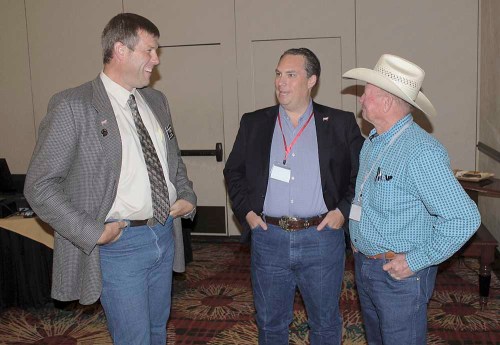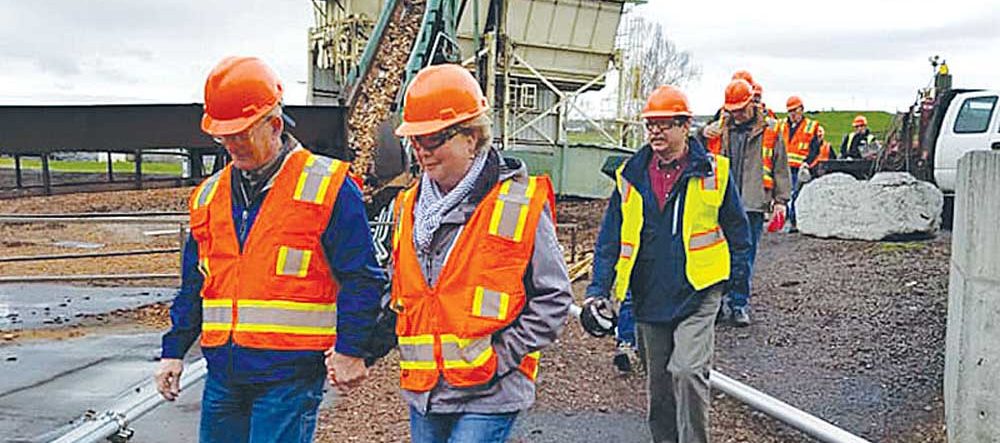Ranchers urged to be part of resource discussions
Published 8:30 am Wednesday, June 26, 2019

- Nathan Jackson, left, president of the Oregon Cattlemen’s Association and manager of the K-Bar Ranches, and Veril Nelson, right, a red Angus rancher, visit with Ethan Lane, a lobbyist who deals with issues on public and federal lands. Lane was a guest speaker at the OCA’s Mid-Year Conference on June 24-25.
CANYONVILLE — When governmental regulations are being considered regarding any number of issues, “we need to make ourselves part of the discussion,” said Ethan Lane.
The “we” Lane referred to are those folks who are involved in agriculture.
Lane is executive director of the Public Lands Council and the senior executive director of National Cattlemen’s Beef Association Federal Lands. He has almost 20 years of experience in natural resources and land use issues.
Lane was a guest speaker at the Oregon Cattlemen’s Association Mid-Year Conference on June 24-25. He emphasized to the gathering of livestock producers that when issues involving the Endangered Species Act, the National Environmental Policy Act, critical habitat areas, grazing on Bureau of Land Management and U.S. Forest Service lands, wild horses and burros, wildlife migration corridors, greenhouse gas emissions and others, those involved need to speak up.
He said more than 2 million comments have been submitted against the U.S. Fish and Wildlife Service’s proposal to remove federal ESA protections and to delist the gray wolf, while only 265 comments favor the delisting.
“That difference is pretty significant,” he said. “Every voice counts. We want to build the strongest case possible to survive a court challenge when there is a delisting.”
Lane said career-level fish and wildlife biologists agree that wolves have recovered and should be delisted. He added that belief goes back to the President Barack Obama administration.
Surveys estimate there are 5,000 gray wolves in the Lower 48 states and 50,000 in Canada.
Personal comments on the proposed wolf delisting will be taken through July 15. Lane said personal comments are better than scripted ones, adding that he suspects the anti-proposal movement is using the latter method.
Lane said another issue getting a lot of debate is wild horses and burros on the western rangeland. He admitted it’s an uncomfortable and unwanted situation of pitting cattle and horse people against one other, “but this issue is more important to us than anybody else regarding that space.”
The wild animals graze the ground where ranchers have grazing permits.
There is a proposal to Congress to fund and provide the authorization to gather and sterilize 20,000 wild horses and burros a year, and to euthanize any animals in poor health.
Lane said there are 88,000 wild horses and burros on the range and 50,000 in off-range facilities, such as pastures and feedlots. He said the wild population is expanding at 20% a year.
Another issue is wildlife migration corridors and big game winter range in western states. Lane said regulations need to authorize states to identify those areas and to manage them.
Lane said the National Environmental Policy Act allows a review of any major action on federal lands. That includes renewal of grazing permits. He said there is a push to streamline grazing permits when no changes are made from year to year to a continuing action, eliminating the potential for lawsuits against the permits.
Lane said the value of grazing is being touted to Congress. He explained cattle grazing on the range or in pastures create only 2% of greenhouse gas emissions. Those against the industry have said that number is much greater.
“We’re not a significant contributor to global warming,” Lane said. “We’re always finding improvements in our industry with managed grazing, rotational grazing.”
Lane also noted that grazing is the most cost-effective wildfire prevention tool, reducing a large amount of highly combustible grass and other forage. He said BLM’s fire prevention treatment cost is from $150 per acre up, depending on conditions. Livestock grazing provides this service at virtually no cost to taxpayers.
“Grazing drives rural economic development,” Lane said. “The footprint of the livestock industry in small rural communities helps keep the lights on at restaurants, stores, gas stations and insurance agencies. The ag community provides a stable business environment for 12 months a year.”
With that in mind, Lane hopes members of the ag community will be inspired to voice their opinion regarding any of these issues and others when proposals and regulations are being discussed.









